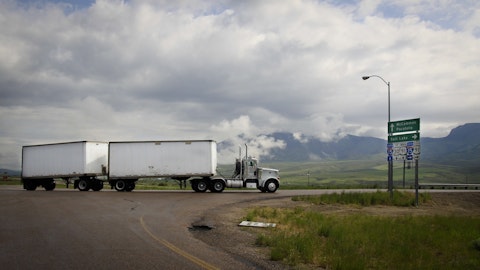Old Dominion Freight Line, Inc. (NASDAQ:ODFL) Q4 2022 Earnings Call Transcript February 1, 2023
Operator: Good day, and welcome to the Old Dominion Freight Line’s Fourth Quarter 2022 Earnings Conference Call. All participants will be in listen-only mode. Please note this event is being recorded. I would now like to turn the conference over to Drew Anderson. Please go ahead.
Drew Andersen: Thank you. Good morning, and welcome to the Fourth Quarter and Full-Year 2022 Conference Call for Old Dominion Freight Line. Today’s call is being recorded, and will be available for replay beginning today and through February 8, 2023, by dialing 1-877-344-7529, access code 2673176. The replay of the webcast may also be accessed for 30 days at the company’s Web site. This conference call may contain forward-looking statements within the meaning of the Private Securities Litigation Reform Act of 1995 including statements, among others, regarding Old Dominion’s expected financial and operating performance. For this purpose, any statements made during this call that are not statements of historical fact may be deemed to be forward-looking statements.
Without limiting the foregoing, the words believes, anticipates, plans, expects and similar expressions are intended to identify forward-looking statements. You are hereby cautioned that these statements may be affected by the important factors, among others, set forth in Old Dominion’s filings with the Securities and Exchange Commission and in this morning’s news release. And consequently, actual operations and results may differ materially from the results discussed in the forward-looking statements. The company undertakes no obligation to publicly update any forward-looking statements, whether as a result of new information, future events or otherwise. As a final note, before we begin today, we welcome your questions, but we ask, in fairness to all, that you limit yourselves to just one question at a time before returning to the queue.
Thank you for your cooperation. At this time, for opening remarks, I would like to turn the conference over to the company’s President and Chief Executive Officer, Mr. Greg Gantt. Please go ahead, sir.
Greg Gantt: Good morning, and welcome to our fourth quarter conference call. With me on the call today is Marty Freeman, our COO, and Adam Satterfield, our CFO. And after some brief remarks, we would be glad to take your questions. The Old Dominion team produced fourth quarter financial results that allowed us to finish the year with company records for annual revenue and profitability. We extended our track record of success and delivered the 10th straight quarter with both an increase in revenue and improvement in our operating ratio. As a result, the fourth quarter of 2022 was also the 10th straight quarter where we produced double-digit growth in earnings per diluted share. Our team produced these results while facing many challenges during 2022, which were primarily related to the unexpected slowdown in the domestic economy.
We entered the year anticipating growth in our volumes that didn’t ultimately meet our initial expectations. But we made the necessary adjustments throughout the year that once again showed the flexibility and resiliency of our long-term strategic plan. We also maintained a watchful eye on the efficiency of our operations and continued with our disciplined approach to managing discretionary spending. Due to our confidence in our ability to win market share over the long-term, one thing that did not change in 2022 was our commitment to investing for the future. Capital expenditures, totaling $775.1 million, in 2022, were a new company record. And we invested $299.5 million in real estate projects that further expanded the capacity of our service center network.
We also continued to invest heavily in our OD Family of employees, with improvements in pay and benefits, as well as a company record contribution to our 401(k) retirement plan for employees. In dealing with the reality of slower than anticipated business volumes we also work diligently to protect the significant investments that we made over the past two years in our new employees. Thinking of new employees, I am proud to share that there have been over 1,300 new drivers that graduated from our internal truck driving school over the past two years. And in some cases, these driver school graduates that now have their CDLs are temporarily working on non-driving roles. While this comes at an increased cost to the company, we believe this bigger pool of licensed drivers will provide us with the strategic advantage once the freight cycle turns and additional volume opportunities become available to us.

Photo by Brian Stalter on Unsplash
We said in our third quarter earnings call that we anticipated volumes could start increasing in the spring of this year. And we continue to remain cautiously optimistic that this will occur despite ongoing risk with the domestic economy. Regardless of the economic environment, I believe our 2022 results provide yet another example of why our long-term strategic plan will remain our focus for the foreseeable future. Consistent execution of this plan had helped us create an unmatched value proposition in our industry that led to over $1 billion of revenue growth for the second straight year, in 2022. I am confident that this commitment to our strategic plan will also continue after my retirement at the end of June, this year. Our long-term success is the result of a strong team and their combined commitment to maintaining a strong company culture.
After working with Marty for most of my career, I can tell you that he lives and breathes the OD Family spirit, and will help take the company to new heights. I think the best is yet to come for Old Dominion. And I look forward to watching OD expand its long-term record of success. Thank you for joining us this morning. And now, here is Marty Freeman to provide some more details on the fourth quarter.
Marty Freeman: Thank you, Greg, and good morning. I would like to start today by thanking Greg and our Board of Directors for providing me the opportunity to lead this great company. It will be an honor to lead our team. And I can assure you that we will work tirelessly to keep producing strong profitable growth. Along those lines, I was pleased with Old Dominion’s revenue growth of 5.8%, and the improvement in our operating ratio to 71.2% during the fourth quarter. The combination of these items contributed to the 21.2% increase in earnings per diluted share. These financial results reflect the ongoing strength and demand for our services as we continue to deliver value to our customers by providing superior service at a fair price.
While our long-term strategic plan is centered on our ability to provide this value proposition, the real key to our success is our strong family culture and our people. We will continue to invest in our OD Family of employees as our employees are the foundation for building strong customer relationships. We are in a relationship business, and each employee plays a critical role to help deliver our industry-leading service. I am proud to report that our service metrics remained strong during the fourth quarter as we provided 99% on-time service, with a cargo claims ratio of 0.1%. We believe executing our same long-term formula for success will allow us to win market share in the future. And as a result, we will — also will allow us to constantly advance to new capacity ahead of anticipated growth.
Our capital expenditures for 2023 are anticipated to be $800 million, which will improve the average age of our fleet and further expand the capacity of our real estate network. We have invested approximately $2 billion in real estate expansion over the last 10 years, and increased our door capacity by approximately 50% as a result. These investments supported our ability to double our market share over this time. The ever-increasing cost of both real estate and equipment however will require us to maintain our pricing discipline. Our long-term pricing philosophy is designed to evaluate the profitability of each customer account, and then obtain the necessary increases to offset our cost inflation, while also supporting our ongoing investment in capacity and technology.
As we have executed on this consistent strategy over the years, the resulting improvement in our cash flow has generally supported our ability to invest between 10% and 15% of our revenue into capital expenditures each year. Continuing with each of these priorities demonstrates our team’s intention to remain focused on executing the same business strategies that we have — created our unique position in this industry. We will continue to focus on our people, servicing our customers, and investing for the future. This commitment to the core principles have differentiated us in the marketplace, gives us confidence in our ability to further produce profitable growth, while also increasing shareholder value. With that, I’ll now turn things over to Adam who will discuss our fourth quarter financial results in greater detail.
Adam Satterfield: Thank you, Marty, and good morning. Old Dominion’s revenue growth, of 5.8% in the fourth quarter, resulted from a 16.7% increase in LTL revenue per hundredweight which more than offset the 9.1% decrease in LTL tons. LTL revenue per hundredweight excluding fuel surcharges increased 8.7% and reflects the continued execution of our long-term pricing initiatives. Our consistent approach to pricing is supported by our ability to provide our customers with superior service and available capacity. We believe this value offering is becoming increasingly important to shipper, which is why we remain absolutely committed to executing on the fundamental elements of our long-term strategic plan. On a sequential basis, revenue per day for the fourth quarter decreased 2.4% when compared to the third quarter of 2022, with LTL tons per day decreasing 4.4% and LTL shipments per day decreasing 4.6%.
For comparison, the 10-year average sequential change for these metrics includes a decrease of 0.6% in revenue per day, a decrease of 1.3% in tons per day, and a decrease of 3.3% in shipments per day. For January, our revenue per day increased approximately 4.2% as compared to January of 2022. This growth included a 13.1% increase in LTL revenue per hundredweight that more than offset the 7.8% decrease in the LTL tons per day. Our fourth quarter operating ratio improved to 71.2%, which is primarily due to an improvement in our direct operating cost as a percent of revenue. Within our direct operating cost, productive labor as a percent of revenue improved 170 basis points, which our purchase transportation costs improved 200 basis points. These changes more than offset the 260 basis point increase in operating supplies and expenses that primarily resulted from a significant increase in the cost of diesel fuel and other petroleum-based products during the quarter.
Our overhead costs as a percent of revenue were consistent between the periods compared. Old Dominion’s cash flow from operations totaled $361.3 million and $1.7 billion for the fourth quarter and 2022, respectively, while capital expenditures were $270.4 million and $775.1 million for the same periods. As Marty mentioned, we currently expect capital expenditures of $800 million in 2023. We utilized $199.9 million and $1.3 billion of cash for our share repurchase program during the fourth quarter and 2022, respectively, while cash dividends totaled $33.0 million and $134.5 million for the same periods. We were pleased that our Board of Directors approved a 33.3% increase in the quarterly dividend to $0.40 per share for the first quarter of 2023.
Our effective tax rate for both fourth quarter 2022 and 2021 was 25.0%. We currently anticipate our effective tax rate to be 25.8% for 2023. This concludes our prepared remarks this morning. Operator, we’ll be happy to open the floor for questions at this time.
See also 10 Cheap Lithium Stocks To Buy and 15 Largest Ophtalmology Companies in the World .
Q&A Session
Follow Old Dominion Freight Line Inc. (NASDAQ:ODFL)
Follow Old Dominion Freight Line Inc. (NASDAQ:ODFL)
Receive real-time insider trading and news alerts
Operator: Thank you. We will now begin the question-and-answer session. Our first question comes from Jordan Alliger with Goldman Sachs. Please go ahead.
Jordan Alliger: Yes, hi, good morning. Question, so on the salary expense side of the equation for the fourth quarter, I think the dollar amount was actually down year-over-year. Can you maybe talk a little bit to your thoughts around the drivers of that, just a lower incentive comp, I think I you had mentioned attrition? And then how do we think about the salary line going forward, whether it be on a wage inflation perspective or a growth perspective? Thanks.
Adam Satterfield: Sure. The overall dollars, obviously we’ve been making adjustments as we’ve gone through the year. And I would say through the back-half of the year, in particular, we’ve been letting attrition take place, and just consistently adjusting our headcount and the hours worked by our people in relation to what the volume environment dictates to continue to give service by continuing to operate efficiently. And so, I think, overall, that helped drive the decrease in that quarter-over-quarter, those expenses, if you will. So, we continue to be focused, obviously, on managing those costs. That’s our biggest cost element of our business is in the salaries, wages, and benefits. And so, it’s certainly the biggest area of focus as we try to continue to run our network as efficiently as possible without giving any sacrifice to service.
So, I do think that given the environment in the fourth quarter, I think we had, given the circumstance, is pretty strong revenue performance. So, I was pleased with the way our revenue and volumes trended. And that was probably one of the favorable line items, if you will, in comparison to the guidance that we had originally provided with respect to the operation ratio, was how the salary, wages, and benefits ended up coming in for us.
Jordan Alliger: Thanks. And just as a follow-up, is there a way to — I mean, do you expect that type of control, at least for the first-half, until you get to that inflection, in the spring, in volumes? I mean, could we continue to see that trend line stay the same for the time being?
Adam Satterfield: Well, I think we’re in a good spot right now with where our headcount is. And typically, we start seeing increases in volume. And certainly, we’re not in a normal environment by any stretch. But our January volumes were slightly positive to the December 1, pretty flattish overall, really when you look at it from a shipment perspective. But we continue to anticipate that we will see volumes return to us in the spring. And I think we want to make sure that we’ve got all elements of capacity in place to deal with that environment whenever it inevitably comes. We’re certainly very confident about what our future market share opportunities will be. And so, we want to make sure that we’re in a position with our people, our equipment, and certainly our service and our network to be able to effectively respond when that does happen.
Typically, the February volumes are a little bit higher than January. And it’s March when we start seeing the increase coming. And so, I think that what we’re trying to do is just, again, measure and manage all elements of capacity to ensure that we’re in a good spot when that happens. So, again, I think that certainly a lot in the first quarter and probably the first-half of the year really depends on what the volume environment gives us. But we continue to believe that we are going to see some increase. We’ve certainly seen it in the past, even in down economic environments, whether you look at something as bad as the environment was in 2009. I think 2016 is another good example, where our second quarter volumes were higher than the first.





